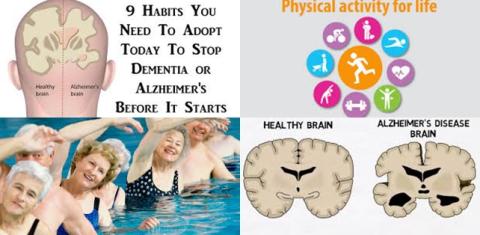
Objectives:
There is considerable evidence of the favourable role of more physical activity (PA) in fighting against dementia. However, the shape of the dose-response relationship is still unclear. Therefore, this review article (meta-analysis) has been conducted.
Does leisure time physical activity reduce risk of all-cause dementia (ACD), Alzheimer’s disease (AD) and vascular dementia (VD) in dose-response manner?
Study design:
This review article included 15 cohort studies with 37,436 participants for all-cause dementia, with 25,031 participants for Alzheimer’s disease and with 16,797 participants for vascular dementia.
During follow-up (3-31.6 years for all-cause dementia, 3.9-31.6 years for Alzheimer’s disease and 4-11.9 years for vascular dementia), at least 2,665, 1,337 and 343 participants who were not suffering from dementia at baseline (=at the beginning of the study) were diagnosed with all-cause dementia, Alzheimer’s disease and vascular dementia, respectively.
There was no publication bias.
Results and conclusions:
The investigators found in the dose-response analysis, either all-cause dementia [p trend 0.005 and p non-linearity = 0.87] or Alzheimer’s disease [p trend 0.005 and p non-linearity = 0.10] exhibited a linear relationship with leisure time physical activity over the observed range (0-2000 kcal/week or 0-45 metabolic equivalent of task hours per week (MET-h/week)).
The investigators found for every 500 kcal or 10 MET-h increase per week, a significantly 10% [95% CI = 0.85-0.97] and 13% [95% CI = 0.79-0.96] decrease in the risk of all-cause dementia and Alzheimer’s disease, respectively.
The investigators concluded leisure time physical activity over a specific range (0-2000 kcal/week or 0-45 MET-h/week) is associated with a risk of dementia and Alzheimer’s disease in an inverse linear dose-response manner; with for every 500 kcal (calories) or 10 MET-h increase per week, a 10% and 13% decrease in the risk of all-cause dementia and Alzheimer’s disease, respectively.
Original title:
Leisure time physical activity and dementia risk: a dose-response meta-analysis of prospective studies by Xu W, Wang HF, [...], Tan L.
Link:
https://www.ncbi.nlm.nih.gov/pmc/articles/PMC5665289/
Additional information of El Mondo:
Find more information/studies on physical activities and dementia here.
If you do a 4 MET activity for 30 minutes, you have done 4 x 30 = 120 MET-minutes or 2.0 MET-hours of physical activity.
|
PHYSICAL ACTIVITY |
MET |
|
Light intensity activities |
3 |
|
Sleeping |
0.9 |
|
Watching television |
1.0 |
|
Writing, desk work, typing |
1.5 |
|
Walking, 1.7 mph (2.7 km/h), level ground, strolling, very slow |
2.3 |
|
Walking, 2.5 mph (4 km/h) |
2.9 |
|
Moderate intensity activities |
3 to 6 |
|
Bicycling, stationary, 50 watts, very light effort |
3.0 |
|
Walking 3.0 mph (4.8 km/h) |
3.3 |
|
Calisthenics, home exercise, light or moderate effort, general |
3.5 |
|
Walking 3.4 mph (5.5 km/h) |
3.6 |
|
Bicycling, 10 mph (16 km/h), leisure, to work or for pleasure |
4.0 |
|
Bicycling, stationary, 100 watts, light effort |
5.5 |
|
Vigorous intensity activities |
> 6 |
|
Jogging, general |
7.0 |
|
Calisthenics (e.g. pushups, situps, pullups, jumping jacks), heavy, vigorous effort |
8.0 |
|
Running jogging, in place |
8.0 |
|
Rope jumping |
10.0 |
